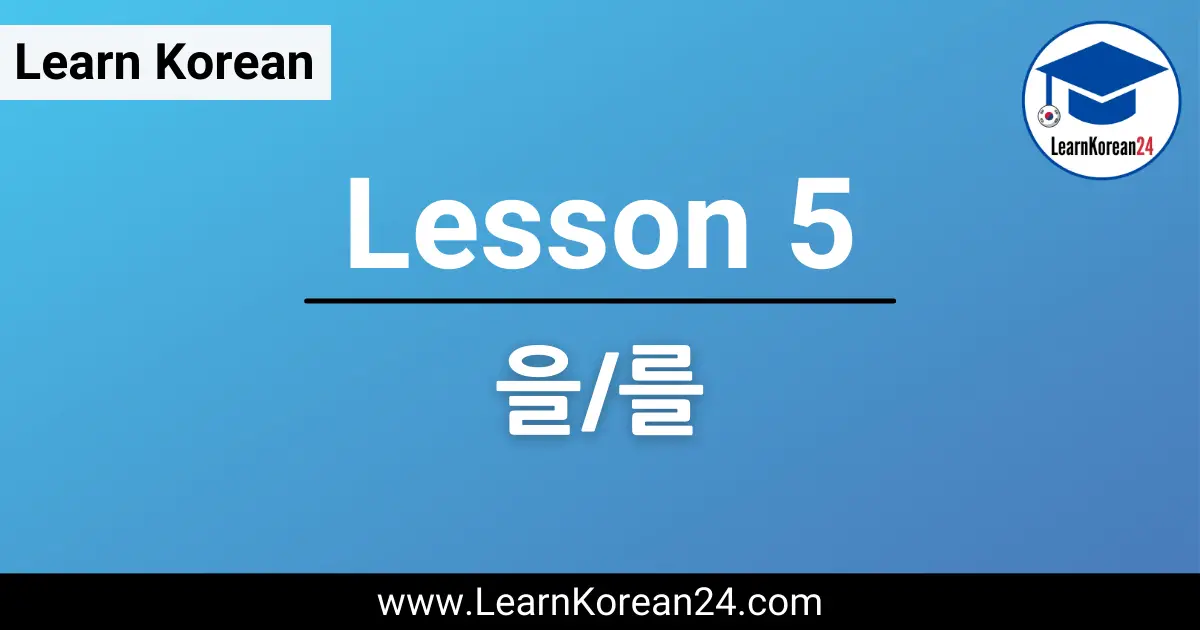Lesson 5: 을/를
In this lesson, you will learn about how to use the particle 을/를 [eul/reul] to ‘mark’ the object of a sentence and make sentences like “I watch movies”, “I drink coffee”, and “I read books”.
Lesson 5:
을/를
KEY INFORMATION
을/를 [eul/reul] = Object Marking Particle
Conjugation 1: Noun ending in a consonant + 을
Conjugation 2: Noun ending in a vowel + 를
을/를 [eul/reul] is what is known as an ‘object marking particle’. If you remember from previous lessons, Korean particles are used to indicate a particular function or grammatical relation of a word in a sentence. The particle 을/를 [eul/reul] marks a noun as the object of a sentence.
If you’re not sure what the ‘object’ of a sentence is, it is the noun that is being affected by a verb. For example, in the sentence “I drink coffee“, ‘coffee’ is the object of the sentence because it is the thing being affected by the verb ‘drink’ (i.e coffee is the thing being drunk). Confused? Don’t worry. Here are some more examples to help explain what we mean:
책을 읽어요. [chae-geul il-geo-yo] = I read books. / I’m reading a book.
친구를 만나요. [chin-gu-reul man-na-yo] = I meet my friend. / I’m meeting my friend.
In the first sentence, 책 (book) is marked with the object marking particle 을 because this is the target of the verb 읽다 (to read) (i.e. the book is the thing being read). In the second sentence, 친구 (friend) is marked with the object marking particle 를 because this is the target of the verb 만나다 (to meet) (i.e. the friend is the thing being met).
You may have noticed that in the first sentence 을 is used to mark the object, and in the second sentence, 를 is used. This is because with nouns that end in a consonant, 을 is attached, and with nouns that end in a vowel, 를 is attached. See the table below.
| Conjugation Rule | Examples |
|---|---|
| Noun Ending In Consonant + 을 | 책을 (book) 밥을 (rice/meal) |
| Noun Ending In Vowel + 를 | 친구를 (friend) 영화를 (movie) |
Tip: Transitive Verbs
The verbs used in the examples above (읽다 = to read, 만나다 = to meet) are called ‘transitive verbs’. Transitive verbs are verbs that always require an object. To help you understand what we mean, think of the verb ‘to read’. You can’t just ‘read’, you need something to read. That is to say, the verb ‘to read’ requires an object such as ‘a book’, ‘a newspaper’, etc.
So, if you’re making a Korean sentence that includes a transitive verb, be sure to mark the object in the sentence with the object marking particle 을/를. Here are some common transitive verbs:
보다 [bo-da] = to see/watch
사다 [sa-da] = to buy
먹다 [meok-da] = to eat
읽다 [ik-da] = to read
마시다 [ma-si-da] = to drink
만나다 [man-na-da] = to meet
배우다 [bae-u-da] = to learn
좋아하다 [jo-a-ha-da] = to like
Example Sentences
책을 읽어요. [chae-geul il-geo-yo] = I read books. / I’m reading a book.
밥을 먹어요. [ba-beul meo-geo-yo]= I eat food. / I’m eating a meal.
영화를 봐요. [yeong-hwa-reul bwa-yo] = I watch a movie. / I’m watching a movie.
친구를 만나요. [chin-gu-reul man-na-yo] = I meet my friend. / I’m meeting my friend.
한국어를 배워요. [han-gu-geo-reul bae-wo-yo] = I learn Korean. / I am learning Korean.
사과를 좋아해요. [sa-gwa-reul jo-a-hae-yo] = I like apples.


